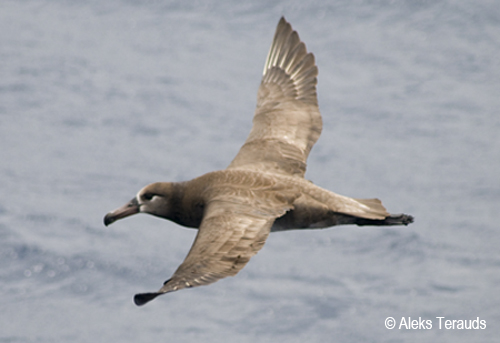Writing in the ornithological journal Ibis, Sarah Gutowsky (Department of Biology, Dalhousie University, Halifax, Nova Scotia, Canada) and colleagues report on at-sea tracking of both fledgling and adult Black-footed Albatrosses Phoebastria nigripes.
The paper’s abstract follows
“Past tracking studies of marine animals have primarily targeted adults, biasing our understanding of at-sea habitat use toward older life stages. Anthropogenic threats persist throughout the at-sea ranges of all life stages and it is therefore of interest to population ecologists and managers alike to understand spatiotemporal distributions and possible niche differentiation between age-classes. In albatrosses, particularly little is known about the juvenile life stage when fledglings depart the colonies and venture to sea with no prior experience or parental guidance. We compared the dispersal of 22 fledgling Black-footed Albatross Phoebastria nigripes between 2006 and 2008 using satellite telemetry and 16 adults between 2008 and 2009 using geolocaters from Midway Atoll National Wildlife Refuge, Northwest Hawaiian Islands. Following tag deployment, all fledglings spent several days within the calm atoll waters, then travelled northward until reaching 750–900 km from the colony. At this point, fledgling distributions approached the productive North Pacific Transition Zone (NPTZ). Rather than reaching the high chlorophyll a densities on the leading edge of this zone, however, fledglings remained in areas of low productivity in the subtropical gyre. In contrast, adult albatrosses from the same breeding colony did not utilize the NPTZ at this time of year but rather ranged throughout the highly productive northern periphery of the Pacific Ocean Basin among the shelf regions off Japan and the Aleutian Islands. The dichotomy in habitat use between fledglings and adults from Midway Atoll results in complete spatial segregation between age-classes and suggests ontogenetic niche separation in this species. This research fills a large knowledge gap in at-sea habitat use during a little known yet critical life stage of albatrosses, and contributes to a more comprehensive understanding of differential mortality pressure between age-classes and overall conservation status for the vulnerable Black-footed Albatross.”

Black-footed Albatross at sea, photograph by Aleks Terauds
With thanks to Barry Baker for information.
Reference:
Gutowsky, S.E., Tremblay, Y., Kappes, M.A., Flint, E.N., Klavitter, J., Laniawe, L., Costa, D.P., Naughton, M.B., Romano, M.D. & Shaffer, S.A. 2014. Divergent post-breeding distribution and habitat associations of fledgling and adult Black-footed Albatrosses Phoebastria nigripes in the North Pacific. Ibis 156: 60-72.
John Cooper, ACAP Information Officer, 31 December 2013

 English
English  Français
Français  Español
Español